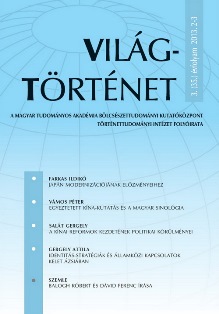Háborús tájkép, jegyrendszer és hatékonyság. A II. világháború hatása egy ipari város társadalmára Indiában
Landscape of War. Rationing and Effi ciency: The World War II in an Indian Industrial Town
Author(s): Robert BaloghSubject(s): History
Published by: Magyar Tudományos Akadémia Bölcsészettudományi Kutatóközpont Történettudományi Intézet
Summary/Abstract: Jamshedpur, the industrial city that has hardly existed for a century, is a unique space in South Asia. TATA Iron and Steel Co. (TISCO) dominates the city and owns much of its territory. TISCO is the major industrial giant of a region that has been an inner frontier for two hundred years. The region, Jharkhand, has also witnessed violent conflict between indigenous tribes, villages and mining ventures over land and forest rich in mineral resources for several decades. This article studies the problem of governing Jamshedpur in the context of the World War II. The need to mobilize resources sheds light on the importance of the changing perception of landscape and human work. Regarding the discourse on floods I point out that TISCO management felt it could control natural environment more extensively within the new framework of development. During the war the region became a military frontier that had to be defended from enemy attack. Regarding human work I highlight two issues. On the one hand, the food crisis of 1942 shows that the lack of the concept of citizenship and the metaphor that saw human body as a motor had an important role in local and national level food policies. On the other hand, diff erences between training schemes that government and TISCO ran tells that British Government was able to overcome racial prejudices about the inefficiency of Indian labour and believed in the capacity of Indian labourers to increase their productivity. Indian elites were less willing to make this move. The years of the World War II drew up structures that forecasted the most salient contradictions of South Asia: the uncertainty of the relationship between citizenship rights and the right to personal security, rigid vertical boundaries within society and the dominant position of large companies in determining the use of landscape.
Journal: Világtörténet
- Issue Year: 2013
- Issue No: 2-3
- Page Range: 365-380
- Page Count: 16
- Language: Hungarian

